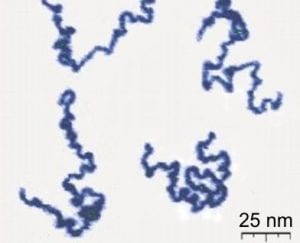
A picture of real linear polymer chains recorded with an atomic force microscope. Source: www.wikipedia.org
Since the beginning of mankind, humans have taken “large substances” and whittled them down to obtain selective parts, such as wood from trees or mineral ores from rocks. Nanotechnology does the reverse, assembling “small substances” on the molecular and atomic level to obtain a desired substance or device. There are a number of benefits to nanotechnology, including the absolute precision and control of the process, the production of little to no waste, the small amount of energy required, and the limited amount of pollutants generated.
Over half a century ago, Richard Feynman stated in his lecture, “There’s Plenty of Room at the Bottom,” that the homogenous properties of polymers, such as amorphous plastic and glass, made them ideal materials for developing nanoscale technologies. Polymers are long molecules consisting of repeating molecular subunits whose properties largely depend on the polymer’s molecular composition and the structure they are arranged in.
Today, polymeric materials are used in the manufacturing sector, although they most often appear in bulk materials. Why is this? An obstacle still remains in the way of Feynman’s vision of polymeric nanomachines. It remains a challenging and controversial issue to determine whether or not such nanoscopic amounts of polymeric material are different from their bulk counterparts.
However, progress is being made. Tress et al have developed a technique for characterizing tiny volumes of polymers and isolated polymer chains. He concluded that the glassy dynamics of an isolated polymer chain are identical to those in the bulk. The ability to assess nanoscopic elements’ structural, electrical, magnetic, and optical properties has led to new tools for probing isolated nanoscopic elements and new innovative ways of using existing tools. Now remains the challenge to develop other noninvasive methods that replicate those findings and demonstrate them in an application.
Some questions about polymers still remain unanswered though. How does the presence of a surface or interface, which increases surface area, influence the configuration and dynamics of a polymer? And because synthetic polymers have a finite molecular weight distribution, and thus have a distribution of molecular sizes, what is the distribution in how different chains respond to conditions such as confinement?
Organic photovoltaics, batteries, and nanoimprint lithography are just a few examples of polymers that have been formed into nanoscopic objects as of now. Countless other possibilities such as coating the nanoparticles used in sunscreen, 3D molecular printing, and aquaphobic materials are also being developed. With growing progress on polymeric nanotechnology research, it is likely that in the not so far future the creation of revolutionary materials in textiles, construction, electronics, and more may propagate faster than ever before.
References:
Russell, T. P. Science 341 6152 (2013)